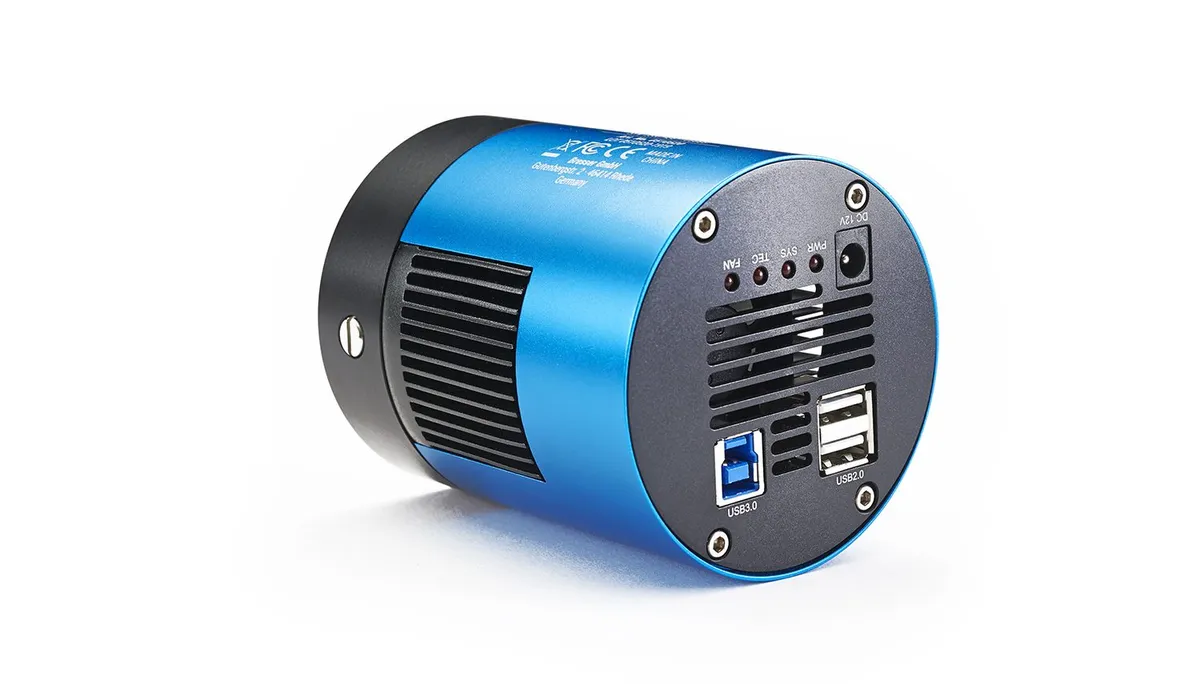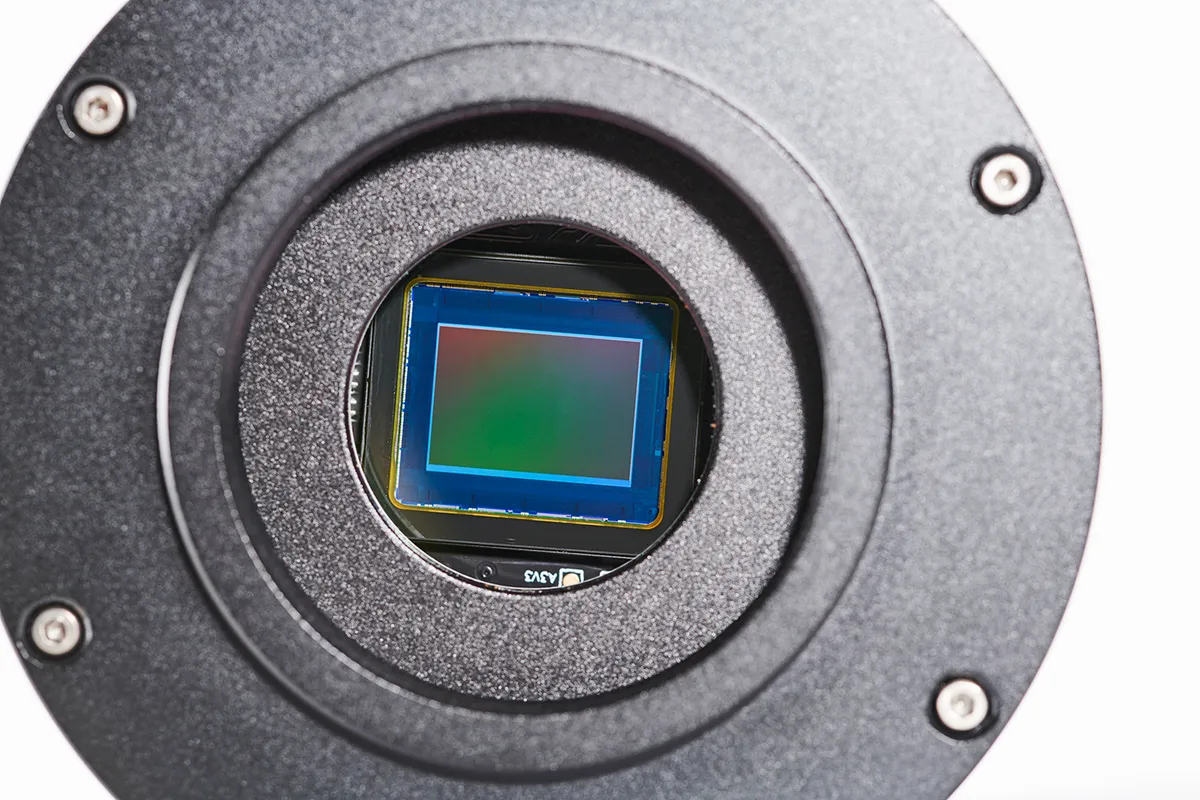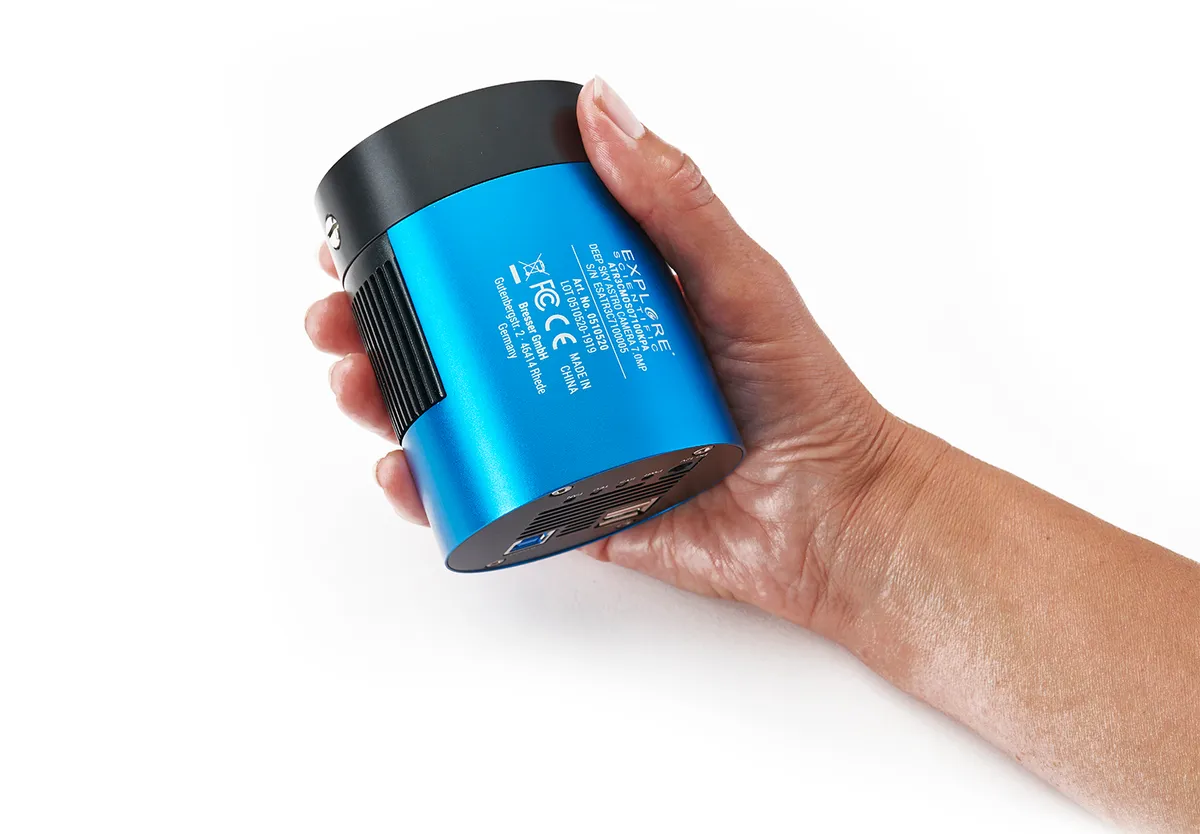Explore Scientific has been manufacturing telescopes, mounts and eyepieces for a good while and now it has launched a range of cooled one shot colour (OSC) CMOS cameras aimed at deep-sky astrophotography. Here we take a look at the Deep Sky Astro 7.1MP, which uses an impressive Sony Exmor IMX428 CMOS colour sensor.
The camera is supplied in a tough black plastic case, along with all the accessories that you’ll need to get started, including a software disc to install all the drivers and software.
With a nice solid feel, the Deep Sky Astro 7.1MP camera is made from lightweight aluminium anodised in blue.
On its back you’ll find the main USB 3.0 socket and a USB 2.0 hub for additional connectivity. There is also a bank of small LED lights and a 12V power socket to attach the included power supply, which is used for the camera’s TEC (thermoelectric) cooling system.
This camera is on our list of the best cameras for astrophotography.

Taking off the front cap reveals the Sony Exmor IMX428 CMOS colour sensor, which has a back focus of 17.5mm from the front of the camera.
Setting up the camera is easy once the software is installed, although we did note that the Explore Capture program is contained on a CD and would be better on a flash drive.
That said, it’s an extensive piece of software that offers lots of controls and settings. If, like many imagers, you prefer to use your own capture software, there is also an ASCOM driver included for doing so.
To begin, we attached the camera to a 115mm Starwave refractor and aimed at the Great Globular Cluster, M13, setting the camera at 60-second exposures with captures to run for an hour.
We noticed two issues as the images started to roll in; the first was a glitch in the ASCOM driver causing the colour to be wrong, and the second was a lot of amp glow – an unwanted glow effect in the images that can indicate a possible problem with the camera itself.
The next day we contacted Explore Scientific to run through the issues and the company responded quickly with updated drivers that corrected the colour and reduced the amp glow.
On the next clear night, we went back to M13 and repeated the capture of 30, 60-second exposures and set about processing the images. There was a marked improvement in the result, with little or no amp glow in the images after processing.

To understand why this is important, for the calibration frames to work, any dark frames must be captured at the same exposure and temperature as the light frames. If there is any difference then amp glow will remain in the images.
With all the clear nights we had we moved on to the spiral galaxies M51 and M81, capturing 60, 60-second exposures using the ASCOM driver to control the camera. As the images came in, we could see the sensor is very capable at capturing targets in a short amount of time.
We set the gain to its minimum setting of 100 under ASCOM through the capture run and found that, even in a single exposure of 60 seconds, objects were bright and the stars were sharp.
The processed images showed very little noise or unwanted artefacts in the background and, considering the short amount of exposure time, there was plenty of detail.
Examining the stars, we noted that we could have reduced the imaging time to around 30 seconds and doubled the amount of exposures; this would have helped to retain star colour and cut down overexposure on brighter targets.
With the Moon shinning bright we switched the camera into Planetary mode and set about capturing some images in Video Capture mode. In Live Capture mode the camera shows quite a lot of green colour, but once the images are processed and colour-balanced there is a lot of detail to be seen.
It would be nice to see some extras included with other cameras in this price range, like a heated sensor window, and the amp glow reduced some more.
This would give some more flexibility in the way the camera is used on single-shot astrophotography. However, all in all we were impressed with the images captured and the results obtained with the Deep Sky Astro Camera 7.1MP.

Speedy delivery
The camera houses a very low noise Sony Exmor IMX428 CMOS 7.1MP colour sensor with a resolution of 3,200 x 2,200 pixels and a size of 14.4mm x 9.9mm. This type of sensor is very sensitive to faint targets and allows you to capture deep-sky objects in a shorter amount of time.
The pixel size of 4.5μm x 4.5μm makes the camera more suitable for telescopes with a short to medium focal length.
Having a full range of ‘region of interest’ features, with a respectable frame rate in these modes, makes the sensor suitable for lunar and planetary imaging too.
For easy control when deep-sky imaging it’s equipped with a global shutter, with 1 x 1 and 2 x 2 bin modes. Having a relatively large field of view makes the framing of objects easy and this is also helpful for fitting in bigger deep-sky targets with larger aperture telescopes.
Overall, the speed that you can capture objects is what makes this sensor a pleasure to use.

USB 3.0 socket
The main computer connection is via a USB 3.0 socket, which allows high-speed captures when imaging objects such as the Moon and planets.
USB hub
Built into the rear of the camera is a two-port USB 2.0 hub, enabling connections to other equipment, such as a filter wheel, electric focuser or guide camera, without the need for lots of tangled cables running back to a computer.
Cooling system
The camera’s temperature can be set up to 40˚C below ambient with the built-in, two-stage thermoelectric cooling (TEC) system. Easy to set in most capture programs, it allows you to capture dark frames at any time and keep the same temperature as for the lights.
Sensor window
The camera’s optical window is AR-coated (anti-reflective) to cut down on reflections in captures. There is also an ltraviolet/infrared coating to reduce unwanted signals and improve star shapes. Without this, images taken with one shot colour (OSC) cameras can produce stars that look quite bloated.
Accessories
A tough, foam-lined plastic case keeps the camera safe and a power supply runs its TEC cooling system. There is also a 2-inch nosepiece for connecting the camera to a scope, plus a software disc containing the Explore Capture program and ASCOM drivers.
Vital stats
- Price £2,099
- Sensor Sony Exmor IMX428 CMOS colour sensor
- Sensor size 14.4mm x 9.9mm
- Resolution 3,200 x 2,200 pixels
- Megapixels 7.1MP
- Size 80mm (diameter), 102mm (length)
- Weight 0.53kg
- Extras T2 thread to 2-inch telescope adaptor; USB 3.0 connection cable (150cm); power supply; dust cap; hard case; instruction manual; software CD
- Supplier Telescope House
- Tel 01342 837098
- www.telescopehouse.com
This review originally appeared in the August 2020 issue of BBC Sky at Night Magazine.